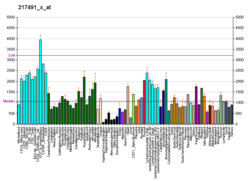Protein-coding gene in the species Homo sapiens
| COX7C |
|---|
|
| Identifiers |
|---|
| Aliases | COX7C, cytochrome c oxidase subunit 7C |
|---|
| External IDs | OMIM: 603774; MGI: 103226; HomoloGene: 135674; GeneCards: COX7C; OMA:COX7C - orthologs |
|---|
| Gene location (Human) |
|---|
 | | Chr. | Chromosome 5 (human)[1] |
|---|
| | Band | 5q14.3 | Start | 86,617,928 bp[1] |
|---|
| End | 86,620,962 bp[1] |
|---|
|
| Gene location (Mouse) |
|---|
 | | Chr. | Chromosome 13 (mouse)[2] |
|---|
| | Band | 13|13 C3 | Start | 86,192,935 bp[2] |
|---|
| End | 86,195,023 bp[2] |
|---|
|
| RNA expression pattern |
|---|
| Bgee | | Human | Mouse (ortholog) |
|---|
| Top expressed in | - right ventricle
- right auricle
- left ventricle
- apex of heart
- muscle of thigh
- human kidney
- prefrontal cortex
- ganglionic eminence
- biceps brachii
- mucosa of transverse colon
|
| | Top expressed in | - quadriceps femoris muscle
- right kidney
- yolk sac
- heart
- proximal tubule
- stomach
- muscle tissue
- neural tube
- skeletal muscle tissue
- jejunum
|
| | More reference expression data |
|
|---|
| BioGPS | 
 | | More reference expression data |
|
|---|
|
| Gene ontology |
|---|
| Molecular function | - cytochrome-c oxidase activity
| | Cellular component | - integral component of membrane
- mitochondrial inner membrane
- membrane
- mitochondrion
- mitochondrial respiratory chain complex IV
| | Biological process | - proton transmembrane transport
- generation of precursor metabolites and energy
- mitochondrial electron transport, cytochrome c to oxygen
| | Sources:Amigo / QuickGO |
|
| Orthologs |
|---|
| Species | Human | Mouse |
|---|
| Entrez | | |
|---|
| Ensembl | | |
|---|
| UniProt | | |
|---|
| RefSeq (mRNA) | | |
|---|
| RefSeq (protein) | | |
|---|
| Location (UCSC) | Chr 5: 86.62 – 86.62 Mb | Chr 13: 86.19 – 86.2 Mb |
|---|
| PubMed search | [3] | [4] |
|---|
|
| Wikidata |
| View/Edit Human | View/Edit Mouse |
|
Cytochrome c oxidase subunit 7C, mitochondrial is an enzyme that in humans is encoded by the COX7C gene.[5][6]
Cytochrome c oxidase (COX), the terminal component of the mitochondrial respiratory chain, catalyzes the electron transfer from reduced cytochrome c to oxygen. This component is a heteromeric complex consisting of 3 catalytic subunits encoded by mitochondrial genes and multiple structural subunits encoded by nuclear genes. The mitochondrially-encoded subunits function in electron transfer, and the nuclear-encoded subunits may function in the regulation and assembly of the complex. This nuclear gene encodes subunit VIIc, which shares 87% and 85% amino acid sequence identity with mouse and bovine COX VIIc, respectively, and is found in all tissues. A pseudogene COX7CP1 has been found on chromosome 13.[6]
References
- ^ a b c GRCh38: Ensembl release 89: ENSG00000127184 – Ensembl, May 2017
- ^ a b c GRCm38: Ensembl release 89: ENSMUSG00000017778 – Ensembl, May 2017
- ^ "Human PubMed Reference:". National Center for Biotechnology Information, U.S. National Library of Medicine.
- ^ "Mouse PubMed Reference:". National Center for Biotechnology Information, U.S. National Library of Medicine.
- ^ Hofmann S, Lichtner P, Schuffenhauer S, Gerbitz KD, Meitinger T (Mar 1999). "Assignment of the human genes coding for cytochrome c oxidase subunits Va (COX5A), VIc (COX6C) and VIIc (COX7C) to chromosome bands 15q25, 8q22→q23 and 5q14 and of three pseudogenes (COX5AP1, COX6CP1, COX7CP1) to 14q22, 16p12 and 13q14→q21 by FISH and radiation hybrid mapping". Cytogenet Cell Genet. 83 (3–4): 226–7. doi:10.1159/000015185. PMID 10072584.
- ^ a b "Entrez Gene: COX7C cytochrome c oxidase subunit VIIc".
External links
Further reading
- Lenka N, Vijayasarathy C, Mullick J, Avadhani NG (1998). "Structural organization and transcription regulation of nuclear genes encoding the mammalian cytochrome c oxidase complex". Prog. Nucleic Acid Res. Mol. Biol. Progress in Nucleic Acid Research and Molecular Biology. 61: 309–44. doi:10.1016/S0079-6603(08)60830-2. ISBN 9780125400619. PMID 9752724.
- Sirchia R, Luparello C (2007). "Mid-region parathyroid hormone-related protein (PTHrP) and gene expression of MDA-MB231 breast cancer cells". Biol. Chem. 388 (5): 457–65. doi:10.1515/BC.2007.059. PMID 17516841. S2CID 2286919.
- Gerhard DS, Wagner L, Feingold EA, et al. (2004). "The status, quality, and expansion of the NIH full-length cDNA project: the Mammalian Gene Collection (MGC)". Genome Res. 14 (10B): 2121–7. doi:10.1101/gr.2596504. PMC 528928. PMID 15489334.
- Strausberg RL, Feingold EA, Grouse LH, et al. (2003). "Generation and initial analysis of more than 15,000 full-length human and mouse cDNA sequences". Proc. Natl. Acad. Sci. U.S.A. 99 (26): 16899–903. Bibcode:2002PNAS...9916899M. doi:10.1073/pnas.242603899. PMC 139241. PMID 12477932.
- Kaminishi H, Hamatake H, Cho T, et al. (1994). "Activation of blood clotting factors by microbial proteinases". FEMS Microbiol. Lett. 121 (3): 327–32. doi:10.1111/j.1574-6968.1994.tb07121.x. PMID 7926688.
- Koga Y, Fabrizi GM, Mita S, et al. (1990). "Sequence of a cDNA specifying subunit VIIc of human cytochrome c oxidase". Nucleic Acids Res. 18 (3): 684. doi:10.1093/nar/18.3.684. PMC 333506. PMID 2155413.
- Van Kuilenburg AB, Van Beeumen JJ, Van der Meer NM, Muijsers AO (1992). "Subunits VIIa,b,c of human cytochrome c oxidase. Identification of both 'heart-type' and 'liver-type' isoforms of subunit VIIa in human heart". Eur. J. Biochem. 203 (1–2): 193–9. doi:10.1111/j.1432-1033.1992.tb19847.x. PMID 1309697.


















